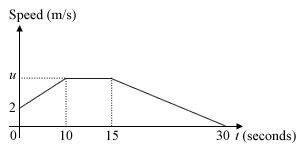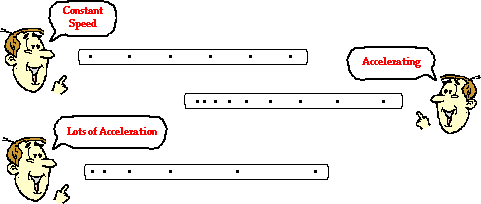What’s Up With Acceleration? Fun Trivia Quiz
-
For what interval of time did the car travel at a constant speed?
-
0-10 seconds
-
10-15 seconds
-
15-30 seconds
-
0-30 seconds
-

Speed can either be fast or slow and is described by the distance covered over time. What do you know about speed and how to understand its changes in a diagrammatical presentation? If you believe you understand acceleration? The quiz below is designed to help you understand what is up with acceleration? The fun quiz below is designed to help you test your understanding of the subject. Give it a shot!
Quiz Preview
- 2.
Which of the dot trails for motion (below) whould show the object is decelerating as it moves to the right. a. * * * * * * * * * * * b. * * * * * * * * * * * c. * * * * * * * * * * * *
-
A
-
B
-
C
Correct Answer
A. AExplanation
The dot trail in option a shows the object decelerating as it moves to the right because the distance between the dots decreases gradually. This indicates that the object is slowing down as it progresses. In contrast, the dot trails in options b and c do not show a consistent decrease in distance between the dots, indicating a constant speed or acceleration instead of deceleration.Rate this question:
-
- 3.
The dot trail patterns above describe the motion of two different objects. As shown one object was moving FAST and the other was SLOW. What motion do they have in common that is shown by the dot trails?
-
Both are accelerating.
-
Both moved for the same amout of time.
-
Both have constant speed.
Correct Answer
A. Both have constant speed.Explanation
The dot trail patterns show that both objects have a consistent and uniform speed throughout their motion. This means that they are not accelerating or changing their speed over time.Rate this question:
-
- 4.
On a velocity time graph what is the slope when the object travels at constant velocity?
-
Positive Slope
-
Negatve Slope
-
No Slope
Correct Answer
A. No SlopeExplanation
When an object travels at a constant velocity, it means that its speed is not changing over time. On a velocity-time graph, velocity is represented on the y-axis and time is represented on the x-axis. In this case, since the object is moving at a constant velocity, the line on the graph would be a straight horizontal line. A horizontal line has a slope of zero, which means there is no slope. Therefore, the correct answer is "No Slope".Rate this question:
-
- 5.
* * * * * * * * * The object is moving to the right. The dot trail for its motion is shown above. Which statement best describes the object motion to the right. (Note the time interval between each dot is constant.)
-
The object has constant velocity
-
The object is accelerating by gaining speed
-
The object is accelerating by reducing its speed
Correct Answer
A. The object is accelerating by reducing its speed -
- 6.
The dot trails above describe the motion of an object moving to the right. Which tape trail above best displays the largest acceleration?
-
Top Trail
-
Middle Trail
-
Bottom trail
Correct Answer
A. Bottom trailExplanation
The bottom trail best displays the largest acceleration because the dots are closer together, indicating that the object is covering more distance in a shorter amount of time. This suggests that the object is accelerating at a faster rate compared to the other trails.Rate this question:
-
- 7.
Which of these ramps is causing the marble to decelerate? (Assume there is NO FRICTION)
-
Marble rolling down a ramp.
-
Marble rolling up a ramp.
-
Marble rolling on a flat ramp.
-
None of these ramps so deceleration.
Correct Answer
A. Marble rolling up a ramp.Explanation
When a marble is rolling up a ramp, it is moving against the force of gravity. As a result, the marble experiences deceleration because the upward force provided by the ramp is less than the downward force of gravity. This causes the marble to slow down and decelerate.Rate this question:
-
- 8.
Which of these is an example of zero acceleration (a = 0.0 m/s/s) acting upon the object?
-
Ball thrown into the air and stops at its highest point above the ground.
-
A car traveling in a straight line at constant speed.
-
A marble rolling up a smooth ramp until it stops before rolling back down the ramp.
-
A car turning in a circle at a constant speed.
Correct Answer
A. A car traveling in a straight line at constant speed.Explanation
The correct answer is a car traveling in a straight line at constant speed. This is an example of zero acceleration because the car is not changing its speed or direction. Acceleration is the rate of change of velocity, so if the velocity is constant, the acceleration is zero. In the other options, the ball thrown into the air and the marble rolling up the ramp both experience a change in velocity, so they have non-zero acceleration. The car turning in a circle also has a change in direction, so it has non-zero acceleration.Rate this question:
-
- 9.
True or False? "An object CAN travel at constant speed and also be accelerating."
-
True
-
False
Correct Answer
A. TrueExplanation
Moving at a constant speed in a circle - is acceleration!
Turning or changing direction is one way to accelerate!Rate this question:
-
- 10.
Which of these driving practices is NOT an example of acceleration?
-
Stepping on the brake pedal.
-
Pressing down on the accelerator (gas pedal).
-
Alllowing Cruise Control to regulate your rate of motion as the car travels in a straight line.
-
Turning the Steering Wheel.
Correct Answer
A. Alllowing Cruise Control to regulate your rate of motion as the car travels in a straight line.Explanation
Acceleration refers to the rate at which an object's velocity changes over time. Stepping on the brake pedal and pressing down on the accelerator are both examples of acceleration because they change the car's speed. Turning the steering wheel is not an example of acceleration because it does not change the car's speed, it only changes its direction. Allowing Cruise Control to regulate the car's rate of motion as it travels in a straight line does not involve any change in speed or direction, so it is not an example of acceleration.Rate this question:
-
- 11.
Describe the motion illustrated by this graph: Which way is the object moving? What is happening to its speed?
-
The object is slowing down while it moves in the negative direction with positive accleration.
-
The object is speeding up while it moves in the positive direction with negative acceleration.
-
The object is slowing down while it moves in the positive direction with negative acceleration.
-
The object is at rest with no acceleration.
Correct Answer
A. The object is slowing down while it moves in the positive direction with negative acceleration.Explanation
The graph shows a decrease in velocity over time, indicating that the object is slowing down. The fact that the velocity is positive indicates that the object is moving in the positive direction. The negative acceleration suggests that the object is experiencing a force in the opposite direction of its motion, causing it to slow down. Therefore, the correct answer is that the object is slowing down while it moves in the positive direction with negative acceleration.Rate this question:
-
- 12.
Calculate the acceleration that started at a speed of 20m/s and accelerated to a speed of 50m/s and took from 5.0 to 8.0 seconds to do so. (Find the change in speed and the elapsed time before you calculate the acceleration.) (graph link is broken but you can calculate it anyway.)
-
30.0 m/s/s
-
10.0 m/s/s
-
3.0 m/s/s
-
6.0 m/s/s
Correct Answer
A. 10.0 m/s/sExplanation
The change in speed is calculated by subtracting the initial speed from the final speed: 50 m/s - 20 m/s = 30 m/s. The elapsed time is calculated by subtracting the initial time from the final time: 8.0 s - 5.0 s = 3.0 s. The acceleration is then calculated by dividing the change in speed by the elapsed time: 30 m/s / 3.0 s = 10.0 m/s/s.Rate this question:
-
- 13.
Which is the BEST SCIENTIFIC definition of acceleration?
-
When motion speeds up.
-
When motion slows down.
-
When velocity changes.
-
When speed changes.
Correct Answer
A. When velocity changes.Explanation
Acceleration is the rate at which an object's velocity changes. It can be positive when an object speeds up, negative when it slows down, or even zero when the object maintains a constant velocity. Therefore, the best scientific definition of acceleration is when velocity changes.Rate this question:
-
- 14.
Which of these examples is the MOST used definition for acceleration because the other definitions are not commonly KNOWN or understood by most people. How do you accelerate your automobile?
-
Speeding Up from 30 to 60 mph.
-
Turning and keeping your speed constant (at 60 mph).
-
Slowing down from 60 to 0 mph.
-
A and B
-
A, B, and C are known by ALL people.
Correct Answer
A. Speeding Up from 30 to 60 mph. -
- 15.
What is assumed or understood to be SAME for the dot trails tapes shown below?
-
Distance between the dots.
-
Time interval between the dots.
-
Type of motion is always acceleration.
Correct Answer
A. Time interval between the dots.Explanation
The correct answer is "Time interval between the dots." This is because the dot trails tapes show a series of dots that represent the position of an object at different points in time. The distance between the dots may vary depending on the speed of the object, but the time interval between the dots remains the same. Therefore, it is assumed or understood that the time interval between the dots is the same for the dot trails tapes shown.Rate this question:
-
- 16.
Four marbles of different mass roll down the same incline from the identical position of 200 cm up the ramp. (Assume no Friction.) Which marble reaches the bottom of the ramp with the greastest speed?
-
Red marble's mass = 20.0 g
-
Blue marble's mass = 35.9 g
-
Green marble's mass = 50.4 g
-
Yellow marble mass = 5.7 g
-
They all reach the bottom with the same speed.
Correct Answer
A. They all reach the bottom with the same speed.Explanation
The mass of an object does not affect its speed when rolling down an incline with no friction. The speed of an object rolling down an incline is determined by the height of the incline and not its mass. Therefore, all four marbles will reach the bottom of the ramp with the same speed.Rate this question:
-
- 17.
The initial speed of a car is 20 m/s. After 30 seconds it's final speed is 50 m/s. What is the average acceleration of the car for the 30 s of time?
-
2.0 m/s
-
1.0 m/s
-
5 m/s/s
-
1 m/s/s
-
0.0 m/s/s
Correct Answer
A. 1 m/s/sExplanation
The average acceleration of the car can be calculated using the formula: average acceleration = change in velocity / time. In this case, the change in velocity is 50 m/s - 20 m/s = 30 m/s. The time is given as 30 seconds. Therefore, the average acceleration is 30 m/s / 30 s = 1 m/s/s.Rate this question:
-
- 18.
The formula for calculating linear acceleration is ....? (or the formula for calculating straight line acceleration is?)
-
A = (Vi - Vf) / t
-
A = Vf - (Vi/t)
-
A = (Vf-Vi)t
-
A = (Vf-Vi) / t
-
A = Vf/t - Vi
Correct Answer
A. A = (Vf-Vi) / tExplanation
The correct formula for calculating linear acceleration is a = (Vf - Vi) / t. This formula represents the change in velocity (Vf - Vi) divided by the time taken (t), giving the rate at which velocity changes over time. By subtracting the initial velocity (Vi) from the final velocity (Vf) and dividing by the time, we can determine the acceleration of an object moving in a straight line.Rate this question:
-
- 19.
The earth revolves around the sun at a constant speed (It travels the same distance in the same time or one revolution per year). Which phrase best describes the earth's motion?
-
The earth travels equal distance in equal time with no acceleration.
-
The earth is revolving at a constant speed with acceleration.
-
The earth is revolving at a constant speed and has no acceleration.
-
The earth is at rest and the sun revolves around the earth.
Correct Answer
A. The earth is revolving at a constant speed with acceleration. -
- 20.
Calculate the acceleration of a vehicle that slows down from a speed of 30 m/s to 10 m/s in an elapsed time of 4.0 seconds. acceleration = change in velocity divided by time = (Vf-vi) / t
-
5 m/s/s
-
10 m/s/s
-
-10 m/s/s
-
-5.0 m/s/s
-
0.0 m/s/s
Correct Answer
A. -5.0 m/s/sExplanation
The acceleration of the vehicle is -5.0 m/s/s. This negative sign indicates that the vehicle is slowing down or decelerating. The magnitude of the acceleration is 5.0 m/s/s, meaning that the vehicle's speed is decreasing by 5.0 meters per second every second.Rate this question:
-
- 21.
On the distance-time graph shown below which motion illustrated is always (constantly) accelerating?
-
Red (Line Segments)
-
Blue (Curving)
-
Green (straight line)
-
Red and Blue
-
None of these
Correct Answer
A. Blue (Curving)Explanation
The blue curve on the distance-time graph represents motion that is constantly accelerating. This can be seen because the curve becomes steeper and steeper as time progresses, indicating an increasing velocity. Acceleration is defined as the rate of change of velocity, so a constant increase in velocity implies a constant acceleration. Therefore, the motion illustrated by the blue curve is always accelerating.Rate this question:
-
- 22.
Which of these are correct metric units for acceleration? (select all correct answers - more than one possible.)
-
Kg/s/s
-
Km/hr/s
-
M/s/s
-
M/s
Correct Answer(s)
A. Km/hr/s
A. M/s/sExplanation
The correct metric units for acceleration are km/hr/s and m/s/s. Acceleration is the rate at which an object changes its velocity over time, and it is measured in meters per second squared (m/s/s) or kilometers per hour per second (km/hr/s). The unit kg/s/s is incorrect because it represents a unit of mass per second squared, not acceleration. The unit m/s is also incorrect because it represents velocity, not acceleration.Rate this question:
-
- 23.
What was the initial speed of the object in this graph?
-
0.0 m/s
-
10 m/s
-
30 m/s
-
2 m/s
-
"u" m/s
Correct Answer(s)
A. 30 m/s
A. 2 m/sExplanation
The initial speed of the object can be determined by looking at the starting point of the graph. In this case, there are two possible answers: 30 m/s and 2 m/s. Both of these values could represent the initial speed depending on the specific context of the graph.Rate this question:
-
Quiz Review Timeline (Updated): Sep 17, 2024 +
Our quizzes are rigorously reviewed, monitored and continuously updated by our expert board to maintain accuracy, relevance, and timeliness.
-
Current Version
-
Sep 17, 2024Quiz Edited by
ProProfs Editorial Team -
Feb 06, 2012Quiz Created by
Grichert
Solve This Acceleration Trivia Quiz!
Solve this acceleration trivia and get to see just how much you have been able to understand from your physics class when it comes to this topic. There are a lot of things that...
Questions:
15 |
Attempts:
832 |
Last updated:
Sep 17, 2024
|
Acceleration, Distance And Time Reasoning Test! Trivia Quiz
Distance and time are the best way of determining the speed at which an object moves. As agreed the exam below was set up to test your understanding on the topic of...
Questions:
10 |
Attempts:
173 |
Last updated:
Sep 17, 2024
|
Acceleration Practice Quiz
The rate of change of velocity is acceleration. It can be positive, negative or even zero. Play this informative quiz to practice some acceleration and time and distance...
Questions:
10 |
Attempts:
844 |
Last updated:
Sep 17, 2024
|
How Much Do You Know About Acceleration?
Quiz for Period 2 Computer based science class. Quiz is from the Holt Science Spectrum.
Questions:
10 |
Attempts:
1329 |
Last updated:
Sep 17, 2024
|
ADDITIONAL: Acceleration And Velocity
This is a quiz about the basic concepts about acceleration.
Questions:
10 |
Attempts:
772 |
Last updated:
Jan 20, 2025
|
Solve This Acceleration Trivia Quiz!
Solve this acceleration trivia and get to see just how much you have been able to understand from your physics class when it comes to this topic. There are a lot of things that...
Questions:
15 |
Attempts:
832 |
Last updated:
Sep 17, 2024
|
 Back to top
Back to top












